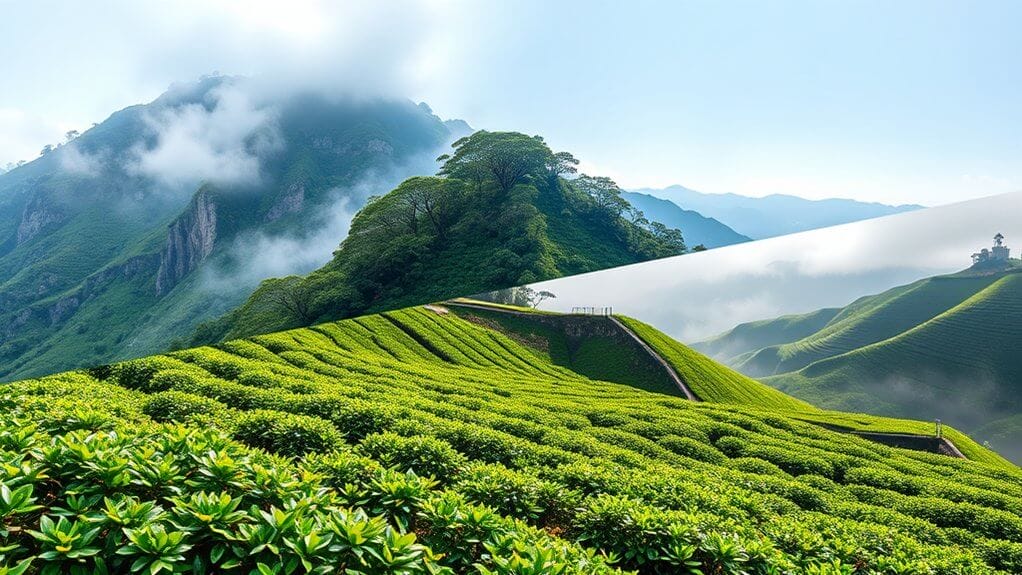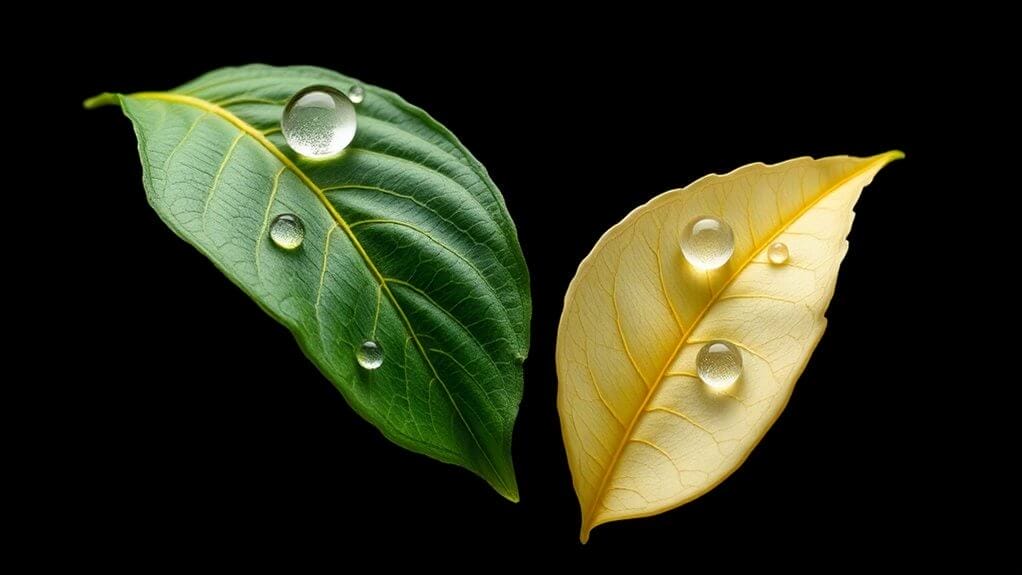High-altitude tea gardens above 1,000 meters produce oolong teas with distinctly different characteristics than their low-elevation counterparts. The cooler temperatures and reduced sunlight at higher elevations slow growth, creating smaller, denser leaves with concentrated flavors. High mountain oolongs showcase complex floral and creamy notes, while valley-grown teas offer straightforward sweetness. The science behind these differences reveals fascinating insights about how elevation shapes a tea's chemical composition and sensory profile.
Key Points
- Higher elevations produce slower-growing tea leaves with denser composition, resulting in more concentrated flavors and complex aromas.
- Mountain teas contain higher benzyl alcohol levels (2.60%) than low-elevation teas (1.04%), contributing to distinct flavor profiles.
- Day-to-night temperature fluctuations at high altitudes create hardier plants and develop more nuanced taste characteristics.
- High-mountain oolongs feature floral and creamy notes, while valley-grown teas exhibit straightforward sweetness with less complexity.
- Nutrient-rich volcanic soils at higher elevations enhance both the taste and nutritional value of oolong teas.
The Science Behind Altitude's Impact on Tea Growth

While many factors influence tea quality, altitude plays an essential role in shaping the character of oolong tea through its direct impact on plant growth. At higher elevations, tea plant adaptation occurs in response to cooler temperatures and reduced sunlight intensity, leading to slower growth rates and smaller, denser leaves. The delicate flavor profiles emerge as a distinctive characteristic of high-altitude teas.
The altitude stress triggers significant changes in the plant's development. Lower average temperatures and frequent mist reduce sun exposure, causing tea plants to produce leaves with concentrated flavors and enhanced aromas. The dramatic day-to-night temperature fluctuations create challenging growing conditions, resulting in hardier plants with more complex flavor profiles. These conditions are especially evident in Nantou County's gardens, where the birthplace of Taiwanese high mountain tea continues to produce exceptional teas. The nutrient-rich volcanic soil, derived from oceanic bedrock, enhances the tea's complexity while contributing to the development of leaves with superior taste characteristics and higher nutritional value.
Chemical Composition at Different Elevations

The chemical composition of oolong tea varies greatly between high and low elevations, as evidenced by distinct volatile compound profiles. High-elevation teas contain remarkably higher levels of benzyl alcohol at 2.60% compared to low-elevation's 1.04%, while showing lower concentrations of linalool and nerolidol. These altitude effects are particularly apparent in the distribution of alkenes, where low-elevation teas show higher overall content at 13.66% versus high-elevation's 9.46%. Total amino acid concentration showed a strong positive correlation with overall tea quality scores in both elevation types.
The most striking differences appear in specific volatile compounds. High-elevation oolong contains α-cedrene, which isn't detected in low-elevation varieties. Conversely, low-elevation teas show considerably higher levels of cyclooctatetraene at 1.48% compared to high-elevation's 0.28%. These chemical variations directly influence the teas' aromatic profiles and flavor characteristics. Analysis through PCA classification methods demonstrated clear differentiation between the two elevation profiles, with hotrienol emerging as a key distinguishing compound.
Flavor Profiles: Mountain Peaks Vs Valley Floors

Due to their distinct growing environments, high-altitude oolong teas showcase remarkably different flavor profiles compared to their valley-grown counterparts. High mountain teas develop complex layers of mountain aromas, featuring elegant floral notes, foggy forest hints, and creamy textures. The slower growth at elevation creates thicker leaves with concentrated flavors, while valley sweetness tends to be more straightforward and less nuanced. The light-bodied qualities of High Mountain Oolong give these teas their characteristic delicate and refined nature. The rare Li Shan winter harvest produces an especially smooth and consistent taste profile that exemplifies high mountain character.
Each high-altitude region imparts unique characteristics: Alishan offers buttery, osmanthus notes; Li Shan presents pear blossom and apple fragrances; and Shan Lin Xi delivers velvety textures with cedar undertones. The daily afternoon fog in regions like Shan Lin Xi contributes significantly to the tea's distinctive savory character. Seasonal variations further distinguish these profiles, with spring harvests producing vibrant, verdant flavors and winter picks yielding more concentrated, complex notes. Light oxidation preserves these delicate high-mountain characteristics, allowing their distinctive qualities to shine through.
Environmental Factors That Shape Tea Quality

Environmental pressures greatly impact oolong tea quality, from soil conditions to climate patterns at varying altitudes. Soil health plays an essential role, as monoculture practices and synthetic fertilizers can degrade the growing environment. Many farmers are shifting to organic practices to minimize chemical runoff into water systems. Tea farmers must balance ideal growing conditions with sustainable practices to prevent erosion and maintain nutrient-rich soil, especially on mountain slopes. Tea plantations using monoculture systems show significantly lower biodiversity compared to other crops like rice and coffee.
The adoption of loose leaf tea helps minimize environmental waste in tea production while delivering superior flavor. Water management becomes increasingly vital at different elevations, with tea production requiring significant water resources. It takes about 15 gallons of water to produce just 4 ounces of tea, making efficient irrigation essential. Climate change further complicates these challenges, affecting both tea yields and quality across elevations. However, sustainable solutions like agroforestry, organic farming, and integrated pest management can help protect soil health while supporting biodiversity and tea quality at any altitude.
Cultural Value and Market Dynamics of High-Altitude Teas

Since their historical emergence during the Qing Dynasty, high-altitude oolong teas have evolved from modest beginnings into prestigious cultural symbols, particularly in Taiwan. This cultural heritage has transformed into significant economic sustainability, with the global tea market now valued at $17.42 billion and growing steadily.
The traditional practices of these growers ensure that teas develop pronounced natural sweetness due to higher carbohydrate concentrations at elevated altitudes.
High-altitude oolongs command premium prices due to:
- Complex cultivation challenges that yield distinctive flavors
- Growing consumer demand for specialty and organic teas
- Limited production capacity in renowned regions like Li Shan and Shan Lin Xi
The market's evolution reflects a broader shift in consumer preferences, especially in North America and Asia Pacific, where health consciousness drives demand for premium teas. E-commerce has further accelerated this trend, making these prestigious teas more accessible to global consumers seeking authentic high-mountain tea experiences.
Conclusion
Like a masterful conductor directing nature's orchestra, altitude orchestrates the complex symphony of oolong tea character. From misty mountain peaks to sheltered valley floors, elevation's invisible hand molds distinctive profiles that dance across the palate. While high-altitude teas command premium prices for their prized qualities, both mountain and lowland oolongs offer unique expressions of terroir that continue to captivate tea enthusiasts worldwide.


